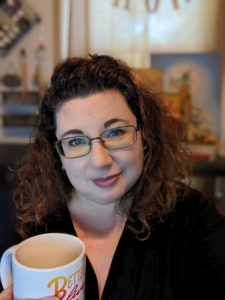Table of Contents
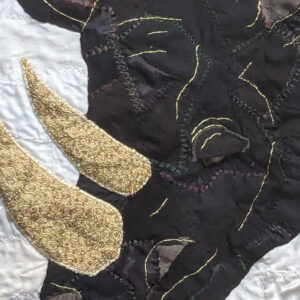
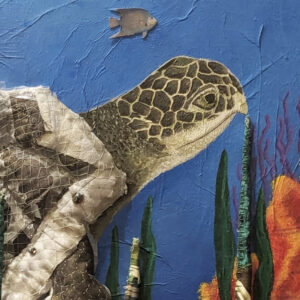
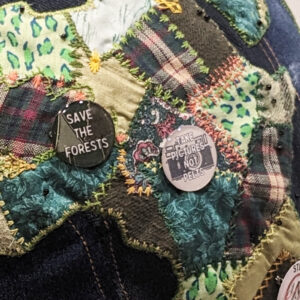
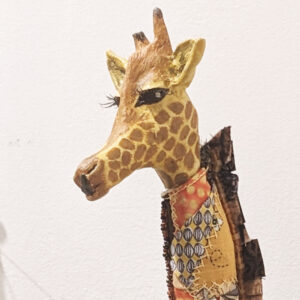
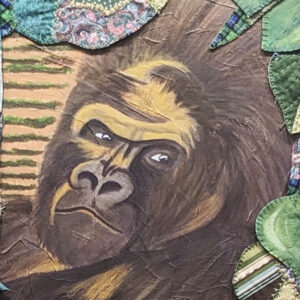
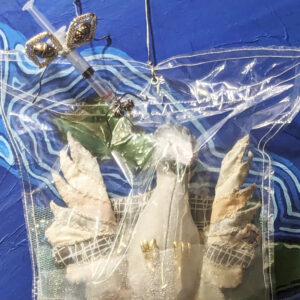
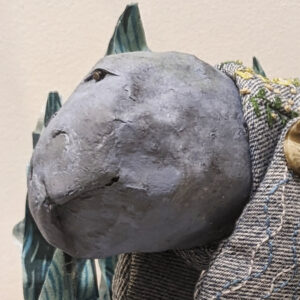
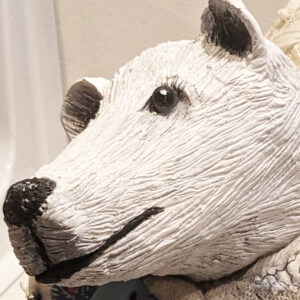
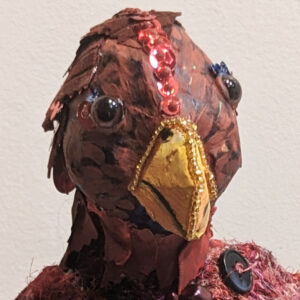
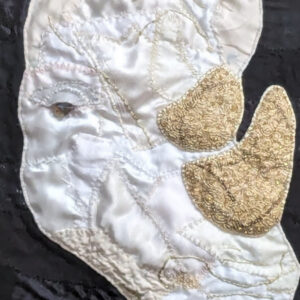
It’s difficult to ignore the ways that fabrics and fashion infuse our lives. I’ve enjoyed working with fabric and embroidery since I was in my teens, and who hasn’t felt a kinship with a particular stuffed animal at some point in their life? Those toys are often what draw us to the plights of the animals they represent. Often, I feel that we have a greater responsibility to speak up for those animals as they have no voice of their own.
At the same time, I was learning more and more about the increases in textile waste due, in large part, to the fast fashion industry. Between the manufacturing of materials, the dyes used, the workers that make them, and where all those close end up at the ends of their short lives, this constant churn of trends is having a devastating effect on our planet. (Read More: The Aftermath of Fast Fashion)
In 2021, these various elements came together with my first sculpture, Gerald. He combines skills learned over decades: traditional jointed toy techniques, Victorian crazy patchwork (aka crazy quilting), embroidery, beading, sculpting, and painting. What started as a single idea has become a series of paintings, sculptures, art quilts, and works that fall somewhere between.
As part of the current Vanishing Treasures show with Margo Ruffin-Hamilton, the Patch Menagerie is enjoying its first time in the spotlight. In addition to pictures of the works, below you can find more about each piece and some of the resources that helped inform them.
Butch
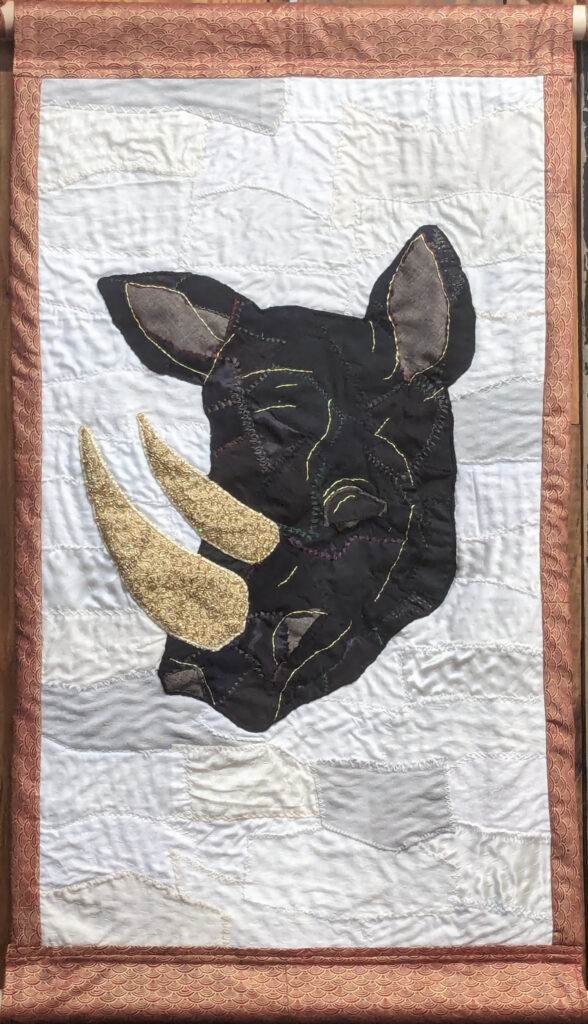
Butch and Tali were created to be shown together but are available as individual pieces. It almost feels wrong to show them singly, but since each represents a different species and their own plights, we do what we must.
Butch represents the Black Rhino (diceros bicornis), a species listed as Critically Endangered by the IUCN. They are poached (that is, illegally hunted) primarily for their horn, which is used both decoratively and in Chinese medicine. Thanks to increased security measures surrounding herds, poaching is on the decline, but their growth rate has been affected. This is why both Tali and Butch feature golden horns.
Black rhinos tend to be smaller than white rhinos and feature a prehensile nose that helps them grasp the leaves from bushes and trees (browse) that they feed on. Even though they are smaller overall, their front horns can grow as long as 19 inches!
The more I delved into ways to incorporate fabric into my art pieces I came across the world of art quilts and what some amazing contemporary artists are doing in that arena. Butch and Tali were my first forays into a more structured sort of quilt, while still incorporating Victorian crazy quilting or crazy patchwork into their portraits and backgrounds.
For more information: IUCN Black Rhino species listing | WWF Black Rhino species page
Dewy
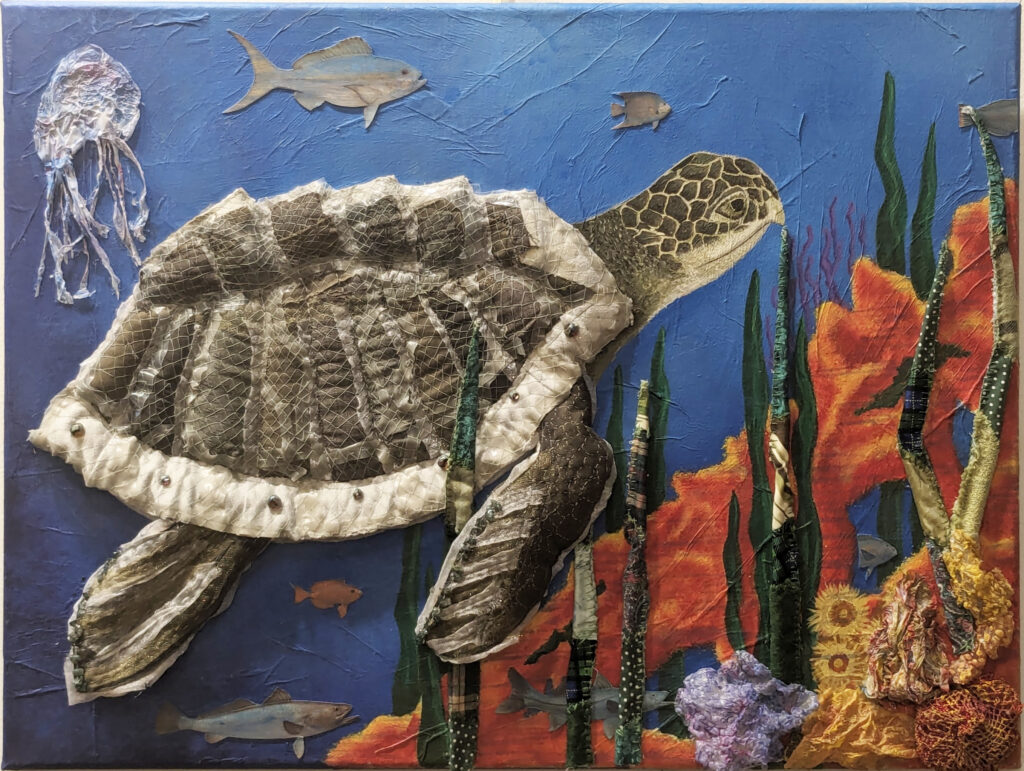
Of the 7 species of sea turtles in our waters, 3 of them are Critically Endangered, like Dewy, a Kemp’s Ridley sea turtle (lepidochelys kempii). They are the smallest of the sea turtles species and make their homes in the waters of the Gulf of Mexico and up the eastern seaboard of the United States. These little guys (and gals) face the biggest risk from bycatch–that’s being caught up in gear from both commercial and recreational fishing that wasn’t meant for them–so a big push has been underway since their population low in the 1980s to aid the population’s recovery.
Aside from bycatch, they also face issues of pollution, climate change, and predation, just like other marine reptiles. They mostly feed on crabs, crustaceans, and mollusks but have been known to mistake plastic waste in the ocean for food. Do you remember having to cut the plastic rings from drink packs growing up? I do! I was surprised to learn that the temperature of the sand the turtles nest in affects the sex of the hatchlings, and rising temperatures due to climate change are posing a significant challenge for turtle nests, along with the more direct impediments of coastal development.
Dewy is one of those pieces that I don’t quite know how to fully describe. The background of water, coral, and seagrass was painted onto canvas prepared with collaged pattern tissue for texture–my usual start to a canvas of any sort. And while his head is painted directly onto the canvas, the rest of his visible body–carapace and flippers–have been “quilted” directly to the stretched canvas. If you look closely you will see the rings of a drink pack sandwiched between fabric and hand embroidery, and a fine net of stitches to represent the threat that bycatch poses. The jellyfish is made from a manipulated plastic grocery bag, as are some of the more dimensional elements of the coral. The fish images are cut from vintage postcards and feature fish common around the Florida peninsula with additional fabric as seagrass.
For more information: NOAA Fisheries Kemp’s Ridley Turtle species page | ICUN Kemp’s Ridley listing | WWF Marine Turtles profile
Gaia

Our next subject needs no introduction or research, does it? After all, we live and work and play here every day of our lives. And yet… There is no denying that storms are more frequent and stronger, that the ice caps are melting at an alarming rate, and the state of the world is changing. What responsibility we, as humans, have played in that, directly or indirectly, is a subject of much debate among many. Personally, I believe the choices we make each day as individuals and a society can help or hurt our future.
Gaia, as a piece of art, came out of a wild hair to procure an old globe (which I did via FB Marketplace) and transform it using the same Victorian crazy patchwork/crazy quilting techniques that I was using in my soft sculptures. What it became was, for me, so much more.
I began by tracing the continents from the globe to ensure each was the correct size and then embroidered pieces of various fabrics (some I’ve been carrying around for more than 30 years, some from more recent sources) in no particular order. I embroidered much of Eurasia while on a cruise to the Bahamas, took Africa and Australia to craft meetups and open studios, and finished the rest of the continents while binge-watching several shows. I realized the continents were taking on the look of interesting patches and, after sharing that with a friend, it was suggested that the oceans would look cool as denim, like a vest or jacket.
That’s when a big conceptual shift happened with this project. Instead of a patchwork globe, the denim seas made it feel more visceral, grungy, and punk. The punk movement–with its themes of anti-consumerism, anti-greed, pro direct action and so forth–goes well with a lot of ongoing conservation ethos and allowed me to bring in more direct messaging to the finish of the globe. Thinking of the sculpture in this way made it easy to lean into the visual cues of that aesthetic: distressed fabrics, scatter pins (which I created with pro-conservation and anti-fast fashion messages), and painted slogans. The use of stretch denim from two pairs of jeggings (which cannot currently be recycled due to the mixed fiber content and the current status of our textile recycling industry) was also a nice touch, I thought.
Then it was time to relate it to the endangered species that are the other part of our world’s plight. After considering several approaches, I opted for a seed bead for each species that has gone extinct in the last 100 years or so. Did you know we’re in the Holocene mass extinction right now? An ongoing extinction event, the last one being the extinction of the dinosaurs. If that sounds alarming, well, I agree. I had much the same feeling when I learned about it. The information I needed for this part of the project was largely gleaned from Wikipedia articles as they have it in one place where my non-scientist brain could easily digest it. There may be some errors in my hand-written notes from all of that, which I take full blame for, but the outcome is overall effective in its execution.
I tell you what, I learned more about world geography in the 7 months of this project than I did in my high school class on the subject. And while I have doubts that even this project would have scored me a passing grade in said class from that particular teacher, I’m over the moon at it overall. I’ve learned so much and it solidifies my commitment to highlight endangered species, conservation, textile waste, and our impact on the environment in my work.
For more information: Wikipedia Holocene Extinction article | Wikipedia Lists of Extinct Species article (note: I concentrated on animal species and did not include plants in this particular roundup)
Suggested reading: The Book of Hope: A Survival Guide for Trying Times by Jane Goodall with Douglas Abrams (affiliate link) Highly suggest the audiobook to hear the conversation in the author’s voices.
Gerald
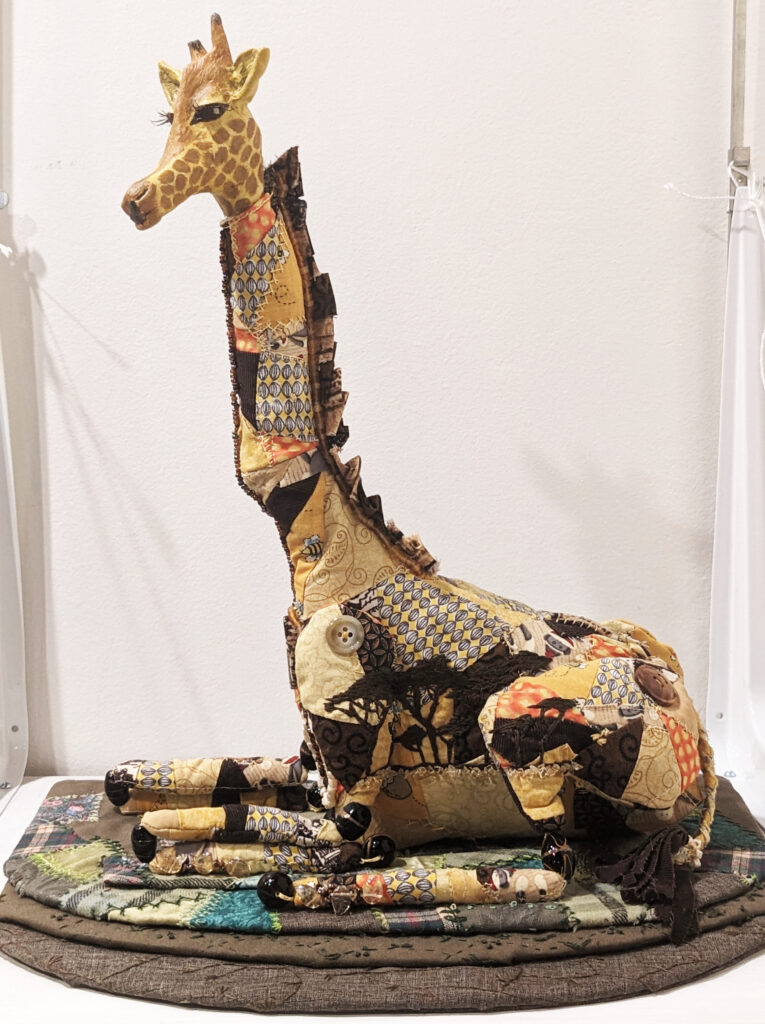
The sculpture that started it all…
When I dreamed up Gerald in that liminal time between waking and sleep one night, I had no idea that giraffes (giraffe camelopardalis) were considered Vulnerable by the IUCN or that, among the 9 subspecies (before this I thought there were only 2: Reticulated and Masai) they range from threatened to critically endangered. Because of this ambiguity, at least one source refers to this as a silent extinction for the most at-risk of them.
Whichever subspecies we’re talking about, their numbers are decreasing the most from a loss of habitat. Population growth of the people around their areas, increased agricultural use of their areas, drought and other environmental changes are all playing a part in the different areas of Africa where giraffes live.
The mental image of Gerald included his patchwork body, jointed limbs, glass beads for his knobby knees and ankles, and a sculpted clay head. It wasn’t until he was more fully formed in front of me that I thought to embroider the silhouettes of the savanna trees they feed on onto the side of his body or add various bead embellishments all around his person. And when he went on display as part of the 2022 THOM Collective exhibition, he didn’t have his base, either. That was a later addition and something I decided was best for all my sculptures going forward, for a variety of reasons.
For more information: IUCN Giraffe species page | World Animal Foundation article
Suggested reading: West With Giraffes by Lynda Rutledge (affiliate link)
H.G. (Honorable Gorilla)
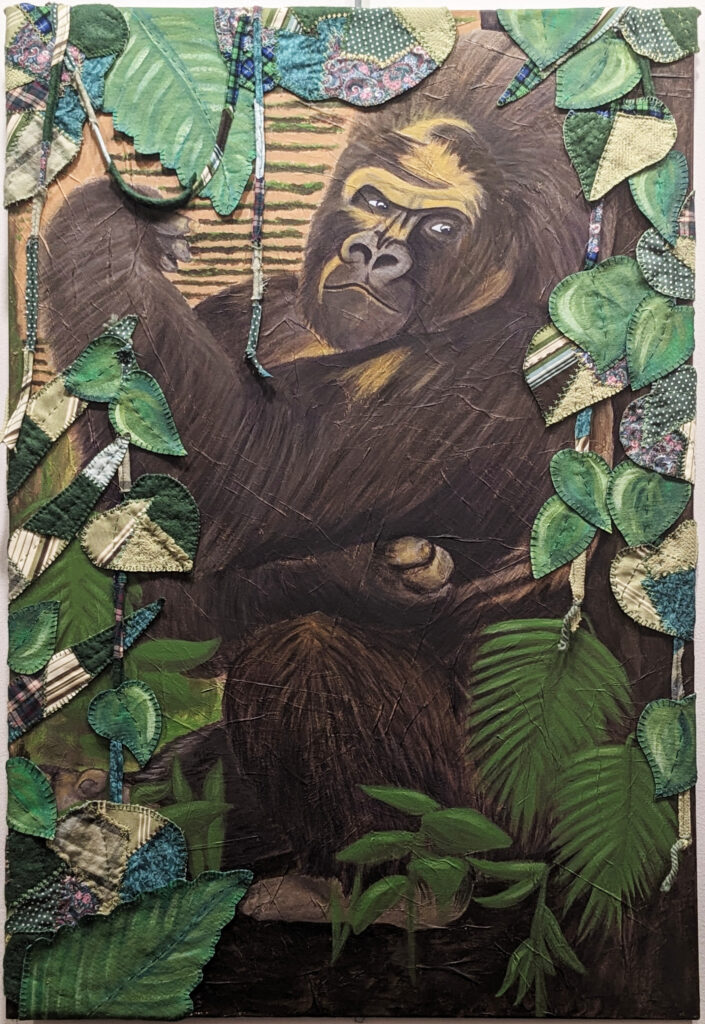
This painting of HG began as a photograph I took at the Jacksonville Zoo several years ago. I loved the way he was posed and the attitude he had. After a bit of digging, I’m almost certain the photo was of Lash, a Western lowland gorilla, though I haven’t yet received full confirmation from the zoo. Apparently, gorilla’s noses are individual enough to tell them apart, and there was only one other silverback gorilla there at the time I was there. Unfortunately, Lash passed away in December, 2022. He was 46 years old.
Did you know that silverback isn’t a species of gorilla but more of a life stage of older male gorillas? Because I did not, at least not until a few years ago. I’ve learned all sorts of things I didn’t know I didn’t know while working on this series.
Western lowland gorillas (gorilla gorilla gorilla) are listed as Critically Endangered by the IUCN. The conversion of land from untouched jungle to logging and mining operations as well as palm oil agriculture encroaches into the gorilla’s natural habitat, yes, but also means there are now roads to previously inaccessible areas that make it easier for poachers to gain access to the geat apes. Close proximity to humans and livestock also brings diseases into the gorilla populations that they have little defense against.
Painting H.G. was something new for me. I’d successfully painted pet portraits before, but on a much smaller scale. This is my largest painting to date. He was first on display in the 2023 THOM Collective exhibition but without the landscape or fabric embellishments, those came almost a year later. I enjoy adding physical dimension and layers to my paintings, so embroidered several patchwork leaves and vines to add to his surroundings. I also painted some unstretched canvas with more leaves, similar to those painted directly on the stretched canvas, to better blend the patchwork leaves into the composition. I must have arranged and rearranged the leaves and vines a dozen times before finally settling on their final placements.
One more word about his name. While H.G. does stand for Honorable Gorilla, it unofficially also stands for “honorary George.” You see, I have an ongoing fascination with monkeys and have oodles of stuffed monkeys, money decorations, monkey jewelry, etc. that I’ve collected over the years. I even painted one on my car. All of the monkeys have George somewhere in their name (totally coincidental to Curious George, by the way, as Curious George is actually a chimp) and we refer to the collection as the George-Borg (I’m also a Star Trek fan). So, even though George is an ape and not a monkey, he fits in well with the rest of the crew, thus the honorary status.
For more information: IUCN Gorilla species listing | Notice of the passing of Lash the gorilla
Kai (No Quinine for Climate Change)
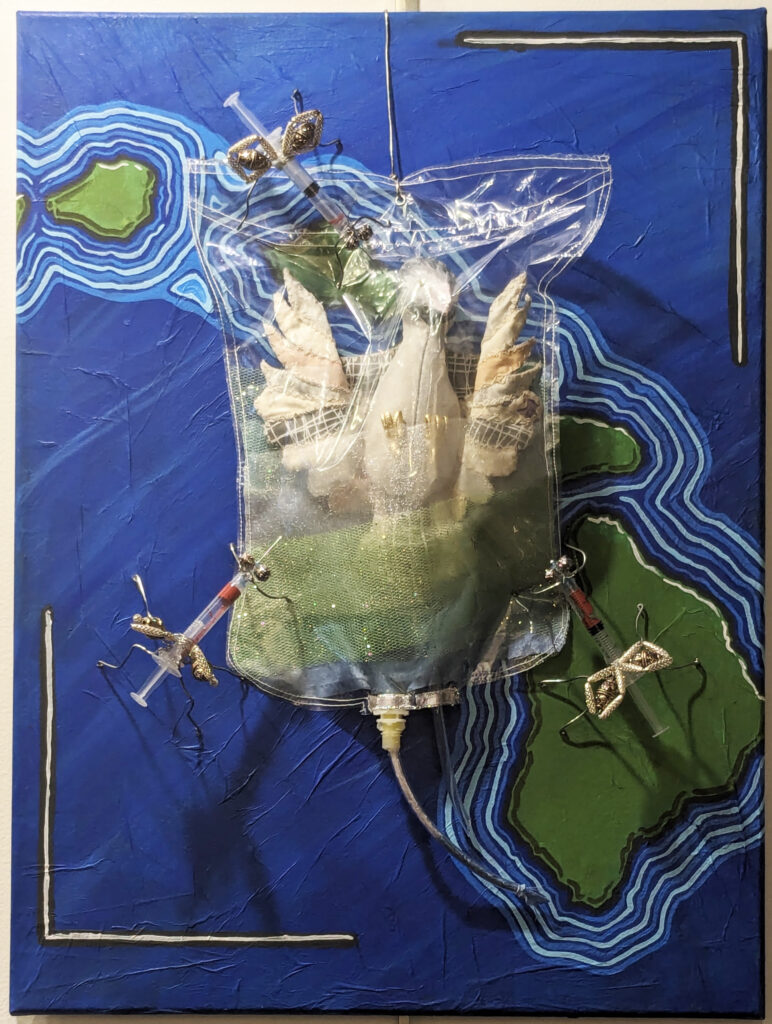
The IUCN lists the ‘akikiki birds of Hawaii as Critically Endangered as of their 2018 assessment, but a more recent article from 2023 reports that there are thought to be only 5 of these small birds left in the wild, edging them dangerously close to the next rung down, “Extinct in the Wild.” That article first came across my news feed in late September, while I was visiting friends in Arizona, and immediately I knew it would become a part of this series.
The ‘akikiki (oreomystis bairdi) live high in the mountains of Kaua’i and were safe there for many years because the non-native mosquitoes that carry avian malaria could not reach them. Unfortunately, rising temperatures due to climate change mean the mosquitoes now have that access and the effect on the ‘akikiki population has been devastating.
Of course, the ‘akikiki are not the only birds who are endangered or have gone extinct in the islands of Hawaii. There have been so many extinctions that the 50th state is known as the bird extinction capital of the world.
The concept of this piece was the result of stream-of-conscious thoughts while reading the original article (see below for link). I knew quinine was a treatment for malaria and thought how nice it would be to have such an easy answer for these birds and the other species facing similar threats. But there is no easy answer, no magic pill, hence the subtitle for this piece: No Quinine for Climate Change. Granted, quinine is generally dispensed in pill form as opposed to IV, but the mental image of this small bird trapped inside an IV bag, beset by mosquitoes, was too vivid to ignore.
I have some history with comics and sequential art, and I recognized that this concept was more along the lines of an editorial cartoon that my other, more straightforward, sculptures or portraits. Kai, as I dubbed my ‘akikiki, is handstitched with a paper mache head (I switched from clay for weight as well as durability), with wired wings and tail so that I could pose him better inside his IV bag (sewn from a large zip-top bag). Quinine fluoresces blue, so fabric remnants of silver, green, and blue line the lower part of the bag and extending through the “IV tubing.” The mosquitoes are made from wires and beads wrapped around hypodermic syringes. The needles were a last minute inspiration, but one that, I think, drives home the point just that much more. (The red liquid inside the syringes is paint, by the way, and I did remove the sharp tips from the needles for safety.) The canvas they are all attached to is painted with a depiction of the Hawaiian islands in a graphic style.
For more information: IUCN Akikiki species listing | CNN article | American Bird Conservancy
Millie
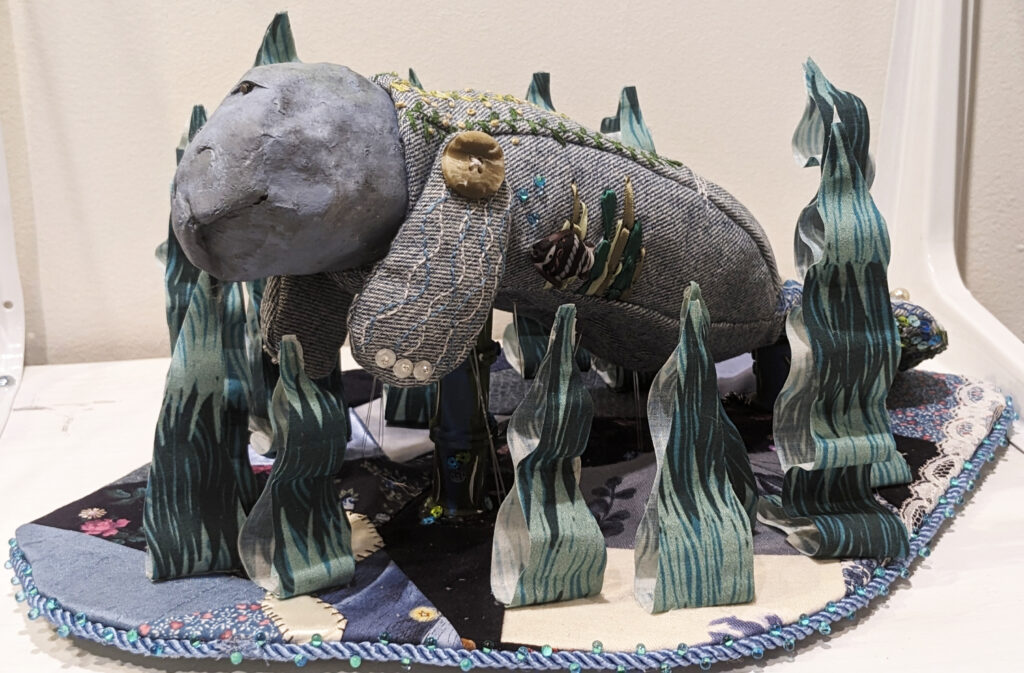
I lived in Florida for 30 years before moving to Georgia, and even now I live just above the Florida-Georgia border; how could I create a series on endangered species and not include the Florida manatee (trichechus manatus latirostris)?
Any child living in Florida learns that manatees, listed as Vulnerable by the IUCN, are gentle giants who are most at risk from human actions, namely boat strikes. They also require plentiful seagrass to eat and warm water to winter in, both of which have been impacted by one thing or another. Power plants that used to create thermal plumes that helped the manatees stay warm over the winter may be closing due to age or changing to alternative technologies that are good for them, bad for the manatees. The warm springs that were a natural home for them have increased demands due to the rising population of Florida and the need for fresh water. Algae blooms, pollution from runoff, and other factors also effect the seagrass beds that the manatee need to survive.
A fun fact–well, story–about manatees is that Columbus, when sailing west in 1492, claimed a mermaid sighting while out and about, but it was really a manatee! I like the idea of a creature also known as a sea cow being thought of as a beautiful mermaid. There are many places in Florida you can visit to see the manatees but just don’t touch them, that’s illegal (though there are plenty of videos of divers being hugged by the creatures and unable to hug them back that are quite amusing, if you can’t get down there yourself).
Millie is the first of my soft sculptures to feature a paper mache head instead of one sculpted of clay. I knew I wanted her to “float” a bit, and my usual head sculpts tend to be both heavy and incredibly fragile. Switching to paper mache also allows me to upcycle materials, so will be my material of choice for sculpting in the near future. She also differs from my other sculptures in her body-form. I used denim from an old pair of jeans for her body and cut and sewed them as-is instead of in a patchwork style. She still features plenty of embroidery, though, between the cascades of algae on her back, the boat-strike “scarring,” wave stitches on her flippers, ribbon-embroidered seagrass on either flank, and the tail stitching to emulate mermaid scales. On the underside of her tail she is fully sequined.
I did not completely dispatch with the crazy quilt techniques, though, as her base is covered in crazy patchwork that I did many years ago in panels to use for pillows (I did make a pair of pillows, but still had plenty of panels left). The seagrass bed she floats in is made of strips of stiffened fabric that I designed and had printed by Spoonflower. I appreciate the ability to print only what is needed via print on demand services and any fabric that was not used has been either saved for future projects or, if too small for even that, put with the fabrics and yarn ends that I used to stuff my soft sculptures. I do my best to use as much of the material as possible, even bits of string and thread trimmed off of embroidery, so that as little as possible ends up in the landfills.
For more information: IUCN Manatee species listing | Save the Manatees
Milos
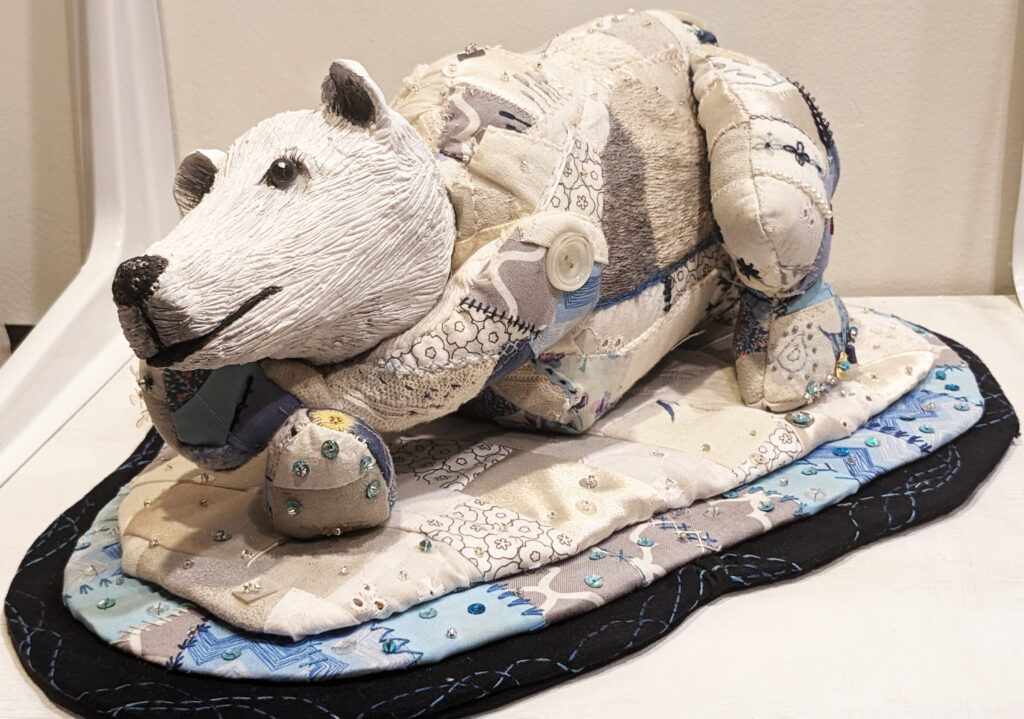
Back in the 90s, I remember watching a show about two abandoned polar bear cubs, Klondike and Snow, during the WFSU holiday pledge drive. Ever since I’ve had a special place in my heart for polar bears (ursus maritimus).
Polar bears live in the arctic circle. They depend on ice floes to feed, and are only able to fill their bellies for the several months of the year when the ice has melted. I feel like it’s common knowledge, by now, that the rise in temperatures due to climate change is causing the glaciers to melt at an alarming rate. This trend is temperatures and ice availability is the biggest threat to polar bears and a signal that we need to pay attention to.
Milos, my second soft sculpture, gave me the chance to build upon what I learned in making Gerald, though the earlier practice didn’t stop me from making a few mistakes along the way, too. Like making the body before I sculpted the head, meaning it took 3 tries to get the proportions even close to correct! And now I have 2 smaller bear heads so, one day, there may be more polar bear sculptures.
On each of his sides, Milos has a thread painting of their glacial habitat stitched in wool-silk yarns. Sequins and crystals dot his body and base to echo the glint of sunlight on ice crystals.
For more information: IUCN Polar Bear species listing | WWF Polar Bear information | Klondike and Snow documentary on YouTube | Polar Bears International
Romeo
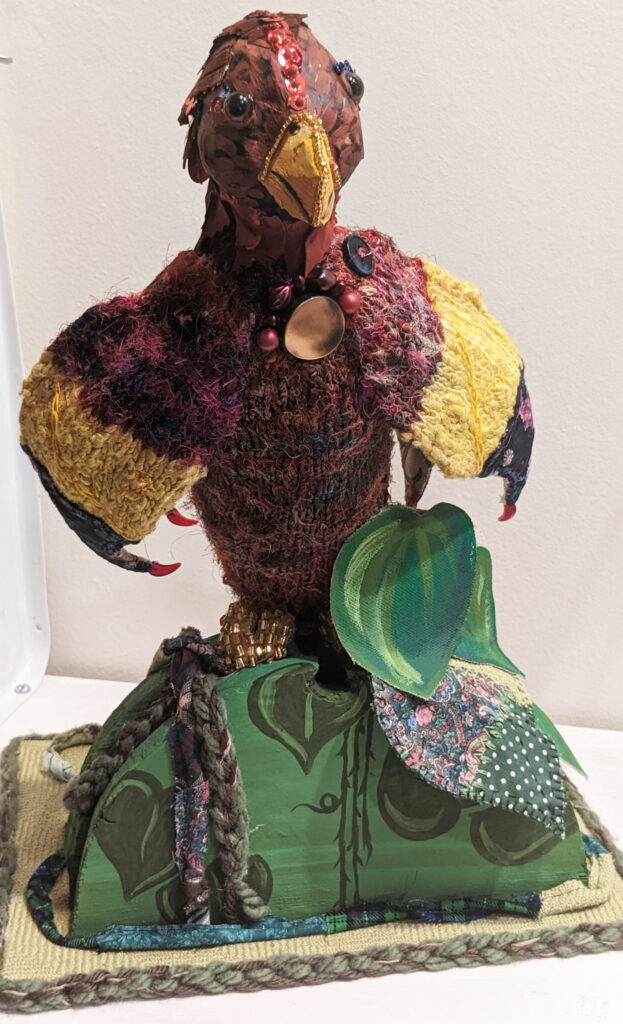
Parrots were not initially on my radar, as far as species to highlight. Not until I remembered the parrot I knit back in 2016 as part of the Fur & Feathered Yarn Bomb project. Romeo started out as a small part of that larger installation, but now gets to stand on his own.
I was and I wasn’t surprised to learn that many parrots are rated Vulnerable or worse by the IUCN Red List. It wasn’t something I was acutely aware of because we’re so used to seeing parrots just everywhere. At the same time, as I was working on Gaia I noticed how many species of birds were in peril on Pacific Islands due to the illegal pet trade and habitat loss due to logging and agricultural concerns. Then there are the increasingly disastrous effects of weather, like the hurricane that nearly wiped out a species of Puerto Rican parrots altogether.
So Romeo doesn’t represent a particular parrot, but the many species that are on the decline. He’s knit of yarn that’s made from recycled saris, which I supplemented with patchwork wings and tail feathers. The wooden hemispheres that make up his perch were pieces of clapboards removed for a ventilation fan during the renovation of my 120-year-old home. And he features a paper mache head adorned with ribbon, sequins, and beads.
For more information: IUCN Grey Parrot listing | IUCN Imperial Amazon listing | IUCN Flores Hanging-parrot listing | Article: Puerto Rican parrot threatened by more intense, climate-driven hurricanes
Tali

Tali, along with Butch, represent rhinoceros species of Africa. While white rhinos as a whole are merely considered Near Threatened by the IUCN, the Northern White Rhino (ceratotherium simum cottoni) is nearly extinct, as the remaining 2 in existence are a non-breeding mother-daughter pair. While efforts are underway in the scientific arena to restart the population through IVF and surrogates, success has yet to be achieved. As with all rhino, their horns have been the big prize for hunters for sale to decorative and Chinese medicine markets. White rhinos often have greater horn weights and tend to live out in the open, making them easier targets for poachers. This is why Tali and Butch both feature golden, beaded horns.
White rhinos also depend on grasses for their food, and were hard hit by the 2015-2016 droughts in their habitats. Not only do the rhinos then depend on the humans around them for security and protection, but also for supplemental feeding during environmental challenges.
As with Butch, Tali’s wall hanging is the result of my continued foray into incorporating textiles into my art. While their two art quilt portraits are fairly straightforward, I look forward to exploring the possibilities in this style with more non-traditional inclusions in the future.
Sources: IUCN White Rhino species listing | WWF White Rhino species page | Ol Pejeta Conservancy, home of the last two northern white rhinos
